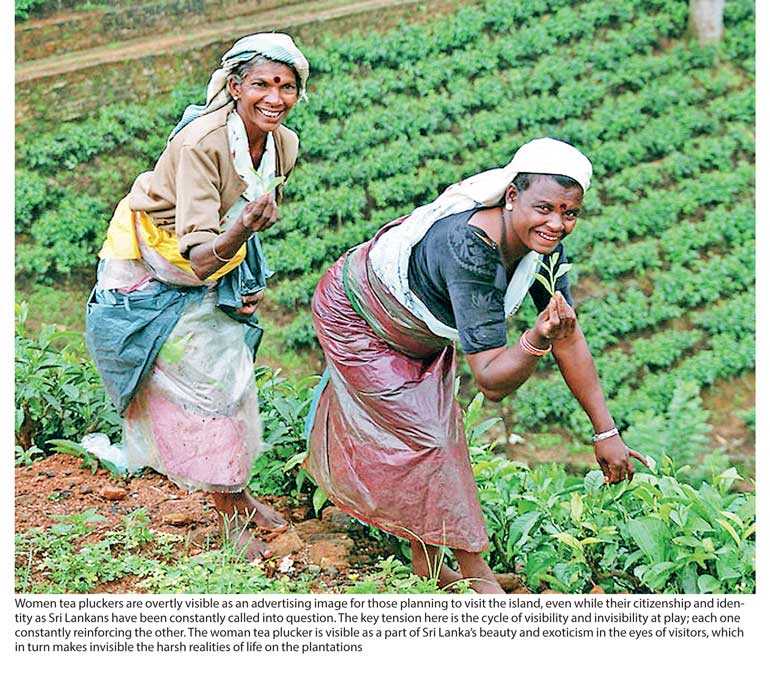Monday Jan 05, 2026
Monday Jan 05, 2026
Wednesday, 5 September 2018 00:00 - - {{hitsCtrl.values.hits}}
 Social media was set alight a few months ago when Jetwing Hotels advertised a new activity for tourists: ‘Meena Amma’s Line Room Experience’. The experience offers its guests a supposedly authentic immersion into “the lives of Sri Lanka’s iconic tea pluckers”i, under the guidance of a former estate worker, Meena Amma. Guests can witness the “simple pleasures of our tea pluckers” but also “a variety of traditional activities characteristic of their lifestyles.”
Social media was set alight a few months ago when Jetwing Hotels advertised a new activity for tourists: ‘Meena Amma’s Line Room Experience’. The experience offers its guests a supposedly authentic immersion into “the lives of Sri Lanka’s iconic tea pluckers”i, under the guidance of a former estate worker, Meena Amma. Guests can witness the “simple pleasures of our tea pluckers” but also “a variety of traditional activities characteristic of their lifestyles.”
While there were certainly supporters of the corporate giant, the reaction was swift and negative from several social media users, prompting Jetwing Chairman Hiran Cooray to issue a response justifying the endeavour. Unfortunately for Jetwing (though we’re sure they’ll recover), Cooray’s non-mea culpa did not satisfy many, with Groundviewsii critiquing the company’s belief that “the commodification of lives such as [Meena Amma’s] brings with it benefit to the community writ large.” 
Naturally, the Jetwing debacle caught our Eye and as we engaged in countless post-mortems, we thought about the importance of specifically demarcating women’s space within tourism. For it is women who bear a specific burden as promotional tools for the industry in Sri Lanka, and elsewhere. The Meena Amma situation is one such example which prompts us to question how the superficial branding and imagery of tourism as a development tool may erase key aspects of women’s experiences.
Currently, Sri Lanka’s tourism model aims to paint tourism as an exchange; through which tourists are given authentic and iconic experiences. In return, communities (especially women) reap the benefits. Yet, the promotion of tourism as an exchange denies the hierarchy of tourism itself, in which tourists occupy a much higher position than industry workersiii. Moreover, the superficial ‘women’s empowerment’ focus of development via tourism invisibilises women’s experiences, waters down what is needed for true social development, and enables the state, investors, resorts, etc., to avoid meaningfully engaging with women and their communities.
Tourism as a development strategy to generate income for those most vulnerable has steadfastly gained prominence amongst international development actors such as the World Bank and the World Tourism Organisation. It nicely fits in with the neoliberal development model, which advocates for economic growth and employment creation as key to positive community transformation.
Central to this has been the framing of tourism as offering more opportunities for self-employment and micro-entrepreneurshipiv. Women in general are often seen as vital to the development agenda. They are branded as the potential ‘saviours’ of their families and communities, who, if given the right resources, can be relied upon to act responsiblyvii. No pressure, of course.
In Sri Lanka, we see this through the push for microfinance initiatives targeted at womeniv,v. So it is not a surprise that the SLTDA is working to better integrate women into the country’s tourism industry, whether through the formal hospitality sector or Small and Medium-Sized Enterprises (SMEs) geared at touristsiv,vi. Branding such initiatives through the empowerment lens, engagement in tourism thus becomes an opportunity for women in developing and post-war countries to improve their mobility, agency and economic independence.
Like ‘slum tourism’ and other similar ‘touristic’ opportunities worldwide, Jetwing’s packaging of the tea plucker experience as one of ‘authenticity’ and ‘simple living’ reflects the Sri Lanka Tourism Development Authority’s 2017-2020 plan to market the country as an “authentic destination for experiential travel”vii. Jetwing is not the only company to perpetuate these ideas. Aitken Spence offers tourists an opportunity to experience the actual work of ‘tea plucking.’ But not to worry! They do not expect “you to produce the minimum 15kg a day that is their target!”viii.
In making light (literally) of the tourist’s experience, offers such as these shape the ‘tourist gaze’ by redirecting it away from people’s real and daily experiences. For the Tamil plantation communities, the history around the loss of citizenship, repatriation to India, ethnic violence and landlessness goes unseen, while tourists are shielded from the ways in which women are disproportionately affected by the intersection of gender with the difficulties of plantation work, ethnic marginalisation and exploitative class and caste relations.
Yet, ironically, we are encouraged to consider women tea pluckers as “iconic” symbols of Sri Lanka. They are overtly visible as an advertising image for those planning to visit the island, even while their citizenship and identity as Sri Lankans have been constantly called into question. The key tension here is the cycle of visibility and invisibility at play; each one constantly reinforcing the other. The woman tea plucker is visible as a part of Sri Lanka’s beauty and exoticism in the eyes of visitors, which in turn makes invisible the harsh realities of life on the plantations.
The representation of women tea pluckers as exotic, feminine and content in promotional imagery also borrows from the ‘colonial imagination’ of the British planter class, reinforcing stereotypes of sexualised and infantilised women from the ‘East.’
Interestingly, the offer of a glimpse into the “simple pleasures” of these women also reproduces colonial discourses implying that small living spaces and low wages are enough to satisfy the needs of the ‘simple’ labourer. Jetwing and Aitken Spence thus exploit the tourist’s demand for what is both supposedly ‘authentic’ and ‘exotic’ about the lifestyle of the communities which they visit. The ‘simple life and pleasures’ of the woman tea plucker is strategically set in contrast to the consumerism of contemporary societies.
This inauthentic branding finds its way into tourism development initiatives as well. On a surface level, the framing of empowering women through tourism can be convincing, especially since many women in the Global South are venturing into new employment areas.
However, the promotion of ‘empowerment in/through the market,’ and of tourism as a possible remedy for gender inequality and poverty, often comes without acknowledgment for the other aspects which inhibit women’s full participation in society, such as ethnic/caste/class discrimination, gender-based violence, a lack of access to reproductive health rights, etc.
These structural issues are not easily challenged by simply introducing job opportunities, especially as these “opportunities” still tend to confine women to certain gendered, and often precarious, work (e.g. the push to involve ‘rural’ women in the production of handicrafts). The disconnect between this reality and the sugar-coated image of women in Sri Lanka’s tourism promotion is stark.
This discussion is not meant to victimise or remove the agency or resistance of women, especially those from marginalised communities and war-affected areas, who participate in tourism. Nor is it meant to imply that they cannot possibly enjoy their work in the industry. In his statement on the backlash,
Cooray emphasised that Meena Amma was the initiator of the experience and was happy to be a part of it. He also discussed how her daughters were educated in the village and are doing well in their respective careersix. However, we should recognise that multiple things can be true at once. We can acknowledge agency and positive experiences, such as Meena Amma’s, while also drawing attention to the aspects of Sri Lanka’s tourism model which are not benefitting women.
The narrative Cooray presented through Meena Amma was one of ‘women’s empowerment,’ and such a narrative has become a popular script to justify the avenues taken within Sri Lanka’s tourism sector and the industry at large. We must be cognisant and critical of how the State and international development actors use women as a promotional tool to both encourage visitors to travel and for the ‘development via tourism’ model, and the ways in which such branding is and inauthentic and harmful.
If stakeholders and policymakers are not taking stock of the complicated realities of women’s lives, then it is imperative that we, as consumers, challenge the rote categorisation of tourism as a positive component of post-war development, and specifically women’s empowerment, in Sri Lanka.
(The Cat’s Eye column is written by an independent collective of feminists, offering an alternative feminist gaze on current affairs in Sri Lanka and beyond.)
Footnotes
i http://www.jetwinghotels.com/jetwingwarwickgardens/things-to-do-in-nuwara-eliya/meena-ammas-line-rooms/
ii Groundviews (2018). “On Meena Amma’s Lineroom Experience.” https://www.facebook.com/notes/groundviews/on-meena-ammas-line-room-experience-and-jetwings-response/10160458788985641/
iii Schmid, K. (2015). “Accumulation by Dispossession in Tourism.” Anthropologica 57(1).
iv Gunasekara, V., Philips, M., Nagaraj, V. (2016). “Hospitality and Exclusion: A study about post-war tourism in Passikudah.” Report 13. Colombo: Centre for Poverty Analysis.
v Kodikara, C. (2018). “Doing This and That: Self-Employment and economic survival of women heads of households in Mullaitivu.” Colombo: International Centre for Ethnic Studies.
vi Ferguson, L. (2009). “Analysing the Gender Dimensions of Tourism as a Development Strategy.” Madrid: Instituto Complutense de Estudios Internacionales.
vii SLTDA (Sri Lanka Tourism Development Authority) (2017). Sri Lanka Tourism Strategic Plan 2017-2020
viii https://www.heritancehotels.com/teafactory/experience/pluck-your-own-tea.
ix http://www.thesundayleader.lk/2018/06/18/jetwing-rejects-social-media-attack-on-meena-ammas-line-room/
x https://commons.wikimedia.org/wiki/File:Sri_Lanka-Tea_plantation-04.jpg
https://upload.wikimedia.org/wikipedia/commons/a/ad/Sri_Lanka-Tea_plantation-04.jpg